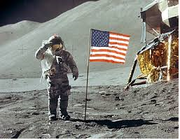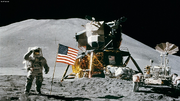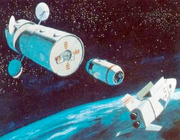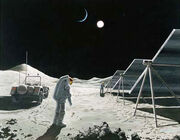The Space Transportation System (STS) was a proposed system of reusable manned space vehicles envisioned by NASA in 1969 to support extended operations beyond the Apollo program. (NASA appropriated the name for its Space Shuttle Program, the only component of the proposal to survive Congressional funding approval.) The purpose of the system was twofold: to reduce the cost of spaceflight by replacing the current method of launching "capsules" on expendable rockets with reusable spacecraft; and to support ambitious follow-on programs including permanent orbiting space stations around the Earth and Moon, and a human landing mission to Mars.
In February 1969, President Richard Nixon appointed a Space Task Group headed by Vice President Spiro Agnew to recommend human space projects beyond Apollo. The group responded in September with the outline of the STS, and three different program levels of effort culminating with a human Mars landing by 1983 at the earliest, and by the end of the twentieth century at the latest. The system's major components consisted of:
- a permanent space station module designed for 6 to 12 occupants, in a 270-nautical-mile (500 km) Earth orbit, and as a permanent lunar orbit station. Modules could be combined in Earth orbit to create a 50 to 100 person permanent station.
- a chemically fueled low-Earth orbit (100-to-270-nautical-mile (190 to 500 km)) shuttle
- a chemically fueled space tug to move crew and equipment between Earth orbits (including geosynchronous), and which could be adapted for use as a lunar orbit-to-surface shuttle
- a nuclear-powered vehicle using the NERVA engine to ferry crew, spacecraft and supplies between low Earth orbit and lunar orbit, geosynchronous orbit, or to other planets in the solar system.
The tug and ferry vehicles would be of a modular design, allowing them to be clustered and/or staged for large payloads or interplanetary missions. The system would be supported by permanent Earth and lunar orbital propellant depots.[1] The Saturn V might still have been used as a heavy lift launch vehicle for the nuclear ferry and space station modules. A special "Mars Excursion Module" would be the only remaining vehicle necessary for a human Mars landing.
This Program was cancelled by Nixon in 1970, rather than moving on to Mars and building up Infrastructure around the Earth-Moon system humanity regressed and has still not seen the achievements made by Apollo since the 1960s. But what if it were different. What if the Political establishment was more than willing to take the next step in establishing the United States as a Spacefaring nation. What would the rate of progress have been? What new technologies and inventions would have been created? How far would we be today?
1960s[]
1969 Apollo 11 successfully touches down in the Sea of Tranquility on July 20, 1969. Neil Armstrong and Buzz Aldrin become the first humans to walk on another celestial body and return safely to the Earth.

PODThe President adds billions back in to the 1970 NASA's budget and works with Democrats and Republicans to get it passed. The new budget retains NASA spending levels at $4 billion/year until 1971 when the budget would increase to $8 billion/year (1969 dollars).
Apollo 12 safely lands on the moon in November 1969. The crew perform a precision rendezvous with the Surveyor-3 spacecraft that had landed in the Ocean of Storms on the moon a full two years prior.
1970s[]
1970
During his first State of the Union Address, President Nixon outlines his agenda for the coming year it includes, in addition to his space initiatives, an educational plan to expand scholarships for students seeking a science or engineering degree. His plan will also have provisions to increase high school graduation rates for Africa-American students; with the hope those rates will match those of whites by 1975. Senator Edward Brooke, America's only black Senator, will lead this committee. The President sees these initiatives as crucial if America is to keep up with the Soviet Union with its larger population base.

Apollo 13 launches. On the way to the moon in April, 1970, a propellant tank aboard the lunar module ruptures. While the crew manages to return safely to Earth, this delays the following Apollo missions. It has the effect, however, of spurring interest in the space program. A disaster that results in the survival of heroes makes both the public and Congress more interested in space. An investigation reveals the incident to have been an extremely improbable event.
The United States orders a second production run of Saturn V rockets to be used for further exploration of the moon. This resumed production after it had stopped in 1967 for budgetary reasons.
The United States selects the Saturn INT-21 to become the workhorse of the American Space Program following the conclusion of Project Apollo. It is derived from the Saturn V rocket used for the Apollo program, using its first and second stages, but lacking the third stage. The guidance unit is moved from the top of the third stage to the top of the second stage.
1971 In January NASA returns to the Moon with Apollo-14. In July, two years after the initial moon landings NASA launches Apollo-15 the final of the short-duration, short-range H-class Apollo missions.
Final decision is made to proceed with development of the space station, earth-to-orbit shuttle and the space tug in FY 1971
1972

The first two Extended duration J-Class Apollo missions launch. An uprated Saturn VB rocket launches three astronauts, an Extended CSM (XCSM) capable of 16 days of flight, and an Extended LM (XLM) capable supporting two astronauts for three days. The XLM has a landed payload capacity of 1000 pounds. NASA flies two Extended Apollo missions per year from 1972 through 1975, plus one in 1976, for a total of nine missions and 54 man-days on the moon.

1973 The first two-stage Int-21 Saturn V derivative launches the first Apollo Applications Program (AAP) Orbital Workshop (OWS) dubbed Skylab. The AAP OWS was a 22-foot-diameter Saturn V S-IVB third stage converted into a temporary space station. Saturn IB rockets launch three CSMs, each bearing three-man crews, to Skylab between early-1973 and early-1974. Despite damage during launch the first crew managed to spend 28 days studying the effects of long term space exposure, the second crew spent 59 days and the final mission lasted 84 days.
1974 A decision to develop the Mars excursion module for an initial manned Mars expedition is made in FY 1974. The final Skylab mission SL-3's CSM and crew safely splashes down upon return to Earth in February.
1975
At the beginning of 1975 began with the launch of a second OWS named Spacelab. A total of nine CSMs deliver crews to the the second AAP OWS by early 1977. This begins the permanent human presence of space.
Reusable IPP spacecraft and semi-permanent bases make their debut in 1975, overlapping with missions using Apollo-Saturn systems helping to ensure that there would be no gap in U.S. manned spaceflight

In May 1975, NASA launches on the fourth Int-21 its first LEO Space Station Module (SSM), the prototype for all subsequent SSMs.The Stations orbit between 200 and 300 nautical miles above the Earth and is used to conduct science, applications, and technology (SA & T) research. It also serves as a depot for cargo bound for GEO and the moon, a satellite repair base, and an assembly and launch control center for automated and manned planetary missions.

Soon after the LEO SSM reached space, the fully reusable Space Shuttle takes wing for the first time. In the LEO SSM’s first year, the winged Shuttle orbiters visits it three times. The 12-man Shuttle orbiter lift offs vertically on the back of a winged, manned booster larger than a 707 airliner, then separates and ignite its own cluster of engines to complete the climb to LEO. It carries up to 65,000 pounds of payload in its 15-by-60-foot payload bay. A Shuttle orbiter is good for 100 flights before retirement.
NASA also conducted a test flight of the Saturn VC, a beefed-up three-stage Saturn V with a Space Tug/LM-B fourth stage. The Saturn VC, is an “interim system” for bridging the gap between Apollo and more advanced IPP lunar systems, capable of placing 100,000 pounds into lunar orbit. The LM-B, a Space Tug with landing legs, could operate on the lunar surface for 14 days at a stretch.
1976 The American Bicentennial year of 1976 began with the fifth Saturn-Int-21 boosting a stack of five fully fueled Space Tug/LM-Bs into LEO. With a full load of liquid hydrogen (LH2) fuel and liquid oxygen (LOX) oxidizer, each Tug/LM-B has a mass of about 50,000 pounds. Space Tug/LM-Bs are be designed for a one-year in-space lifetime. Beginning in 1976, one Space Tug/LM-B is be based at the LEO SSM at all times for use in satellite servicing, spacecraft assembly, Earth-orbital rescue, and other missions.
The Last Apollo mission, Apollo-24 lands on the Moon and returns safely to Earth.

Early in 1976, a Saturn VC launches a 50,000-pound Space Station Module and a fully fueled Space Tug/LM-B to near-polar lunar orbit. During 1976, 1977, and 1978, nine Saturn VCs launch four Space Tug/LM-Bs and five four-man QCSMs to the lunar-orbit SSM, enabling a continuous lunar orbit population of four astronauts. The QCSM is be an interim system like the Saturn VC. Two-man crews land on the moon in Space Tug/LM-Bs four times in 1976, five times in 1977, and four times in 1978. Each trip to the lunar surface and back would expends 50,000 pounds of LN2/LOX propellants.
The lunar-orbit SSM keeps two fully fueled Space Tug/LM-Bs on hand at all times. One would land on the moon and the other would stand by to rescue the surface astronauts in the event that their Space Tug/LM-B malfunctioned. After a year of operations, Space Tug/LM-Bs based at the lunar-orbit SSM are stripped down and turned into tankage for a propellant depot in lunar orbit.

Also in 1976, the Space Shuttle flies eight times. Six Shuttle missions deliver astronauts, supplies, and cargoes, including two automated planetary spacecraft, to the LEO SSM. The remaining two missions see the Shuttle orbiter serve a “tanker” role. Each Shuttle carries 50,000 pounds of LH2/LOX propellants, enough to refuel one Space Tug/LM-B.
The first two missions of the Balanced Base planetary program, the Venus Explorer Orbiter and the Comet d’Arrest flyby, depart Earth in 1976.
1977
In 1977, the Space Shuttle flies 10 times and the Saturn Int-21 would fly twice. The Space Tug/LM-B could not carry enough propellants to change from near-equatorial LEO SSM orbit to polar orbit, so two Shuttle orbiters launch directly from Earth’s surface into polar orbit to perform sortie (non-space station) missions. Polar sorties occur at a rate of two per year through 1984.
Eight Shuttle missions transport crews and cargoes between Earth and the LEO SSM. One of those also delivers to the LEO SSM 50,000 pounds of LH2 propellant for the first NERVA nuclear-thermal rocket engine-equipped Nuclear Shuttle, and four deliver 50,000 pounds of Space Tug/LM-B propellants each.
One Saturn Int-21 launches the first Nuclear Shuttle and another launches five fully fueled Space Tug/LM-Bs (four for the robotic planetary program and one for the LEO SSM). The Int-21 would isn't able to launch the Nuclear Shuttle to LEO fully fueled, so it reaches space with room in its tank for an additional 50,000 pounds of LH2 propellant. Before a newly launched Nuclear Shuttle departed LEO for the first time, a Shuttle orbiter tanker would rendezvous with it to top off its tank.
Nuclear Shuttles are each be good for 10 missions from LEO to GEO or lunar orbit and back, before being launched into disposal orbit around the Sun. Some would carry a cargo of spent Space Tug/LM-Bs into solar orbit with them.
Each Nuclear Shuttle mission expends 240,000 pounds of LH2. Six Space Shuttle tanker flights are required to refuel the Nuclear Shuttle once. The Nuclear Shuttle would transport to the lunar-orbit SSM six astronauts and 90,000 pounds of cargo, or 100,000 pounds of cargo in unmanned mode. It can return 10,000 pounds of cargo and six astronauts from the moon to the LEO SSM.

The Nuclear Shuttle can deliver 90,000 pounds of cargo and six astronauts to GEO and return six astronauts from GEO to the LEO SSM.
The first Nuclear Shuttle would operate only in unmanned mode; its 10 missions would in effect serve as an extended flight test, meanwhile delivering SSMs to the lunar surface using one-way Space Tug/LM-Bs.
In 1977, four Tug/LM-B pairs would launch the Mars Explorer Orbiter, the Mars High Data Orbiter, and two Jupiter-Saturn-Uranus-Neptune Mariner-class flyby spacecraft (part of the "Planetary Grand Tour" program). The Space Tug/LM-B's used to launch the Mariner probes to the outer solar system were not reused as there was simply not enough fuel to return to Earth. Instead they continued outwards with the probes into Interstellar Space.
The ninth Spacelab CSM returns to Earth, the last launch of the Saturn IB and the last use of the CSM bring an exciting end to the Apollo-Saturn Program. Both Skylab and Spacelab remain on orbit as possible safe-havens should astronauts find themselves in an emergency.
1978 The first manned Nuclear Shuttle, the second launched, would reach LEO on an Int-21 in early 1978. Four manned and six unmanned Nuclear Shuttle flights would occur each year beginning in 1978, by which time one new Nuclear Shuttle would reach LEO and one old Nuclear Shuttle would be disposed of in solar orbit each year.

The first Lunar Surface base became continuously occupied as Space Tug/LM-B's deliver crews of two astronauts each to the pre-established Lunar Surface Base (comprised of SSMs similar to those used in LEO and Lunar Orbit). Both the lunar surface and lunar orbital population remains at 6-men each (12-men total).
Meanwhile, a Saturn INT-21 delivers a Mars Excursion Module to LEO for on-orbit testing and a manned re-entry simulating Martian landing conditions. The event was widely televised.
The year 1978 sees a Mercury-Venus Mariner flyby, a Venus-Mariner Orbiter, and a Solar-Electric Asteroid Belt Survey depart the LEO SSM. All Space Tug/LM-Bs used to launch these missions are recovered and reused. 1979
In 1979, NASA would launch the 6000-pound Mars Soft Lander/Rover and two Jupiter-Saturn-Pluto Mariner-class flybys, expending two Tug/LM-Bs.
Skylab reenters and breaks up over the Indian ocean and Australia.
1980[]
1980
Between 1979 and 1981 Int-21s would launch three more LEO SSMs. These would be combined with the first LEO SSM to form a "Space Base" with a 48-man crew. In 1980, an Int-21 would launch into LEO an SSM that would be mated to a Nuclear Shuttle and boosted to Geosychronous Orbit (GEO) achieving another 12-men base. Further, the Lunar Orbit Base was expanded by launching additional Nuclear Shuttle flights to deliver additional SSMs to the existing one growing the Lunar Orbit Base's crew size to 24-men.

50 Person Space Bae in 1980
Beginning now, all Nuclear Shuttles perform a shakedown cruise to GEO before traveling to lunar orbit for the first time. If it malfunctioned during its maiden flight to GEO, a Space Tug/LM-B could rendezvous with it to make repairs or return it to the LEO SSM.
At the turn of the decade, a continuous population of 90 NASA Astronauts were living and working in LEO, GEO, Lunar Orbit and on the Lunar Surface. But things were about to become even more ambitious.
In 1980, a second Venus Explorer Orbiter would leave Earth, as would two Jupiter Flyby/Probe spacecraft. The latter would expend two Tug/LM-Bs.
1981 The year 1981 would see a second Mars Explorer Orbiter, two Saturn Mariner-class Orbiter/Probes, and two more expended Tug/LM-Bs.
12 November, NASA’s first manned Mars expedition departs Earth orbit. The mission employs two identical 270 ft long spacecraft comprising of SSMs boosted by three Nuclear Shuttles. All the components were launched by Saturn INT-21's and assembled together in orbit via docking facilitated by Manned Space Tugs. Each ship has a crew of six astronauts. In the event of an accident, the entire twelve-man crew can be sustained by a single spacecraft.
1982

First piloted landing on Mars, August 9, 1982.
9 August, The Mars mission goes into orbit around the Red Planet. The first eight humans to walk on another planet descend in their two Mars Excursion Modules (MEM) to spend 60 days exploring the surface. Their objectives include studying Martian geology, searching for life, and prospecting for resources for future Mars expeditions. Each of the two Mars Excursion Module brings down a crew of three while the two Orbiters remain crewed by three crew each. In the event one Mars Excursion Module isn't capable of launching back to Mars Orbit, the entire crew of six can launch in the other.
October 28 After spending 80 days orbiting Mars the crew leaves the Planet and fire the remaining NERVA Shuttle for Trans-Earth-Injection.
1983
28 February. The returning Mars expedition flies past Venus and deployed two Venus Entry Probes. Meanwhile, the second Mars mission is preparing to leave Earth (it returns in 1985). Venus also got another Venus Explorer Orbiter and a Venus Mariner Orbiter/Rough Lander in 1983.

14 August. The first Mars mission arrives back in orbit around Earth. Fearing contamination by Martian organisms, the crews are quarantined in Space Base until it is ruled safe for them to return home. The second Mars expedition already launches.
1984 The Space Base is further expanded to include a full crew complement of 100-men while the GEO Base is doubled from a 12-man crew to a 24-man crew. Finally the Lunar Surface Base is completed with it's final crew size standing at 48-men. This brings the total number of people living and working in Space to 196 (218 when including the temporary Mars expedition).

100 Person Space Base in 1984
1985 The second mission to Mars swings past the planet Venus and returns to Earth.
1986 A Temporary 12-man Base is established on the Surface of Mars by the third Mars Expedition.
1987 The third Mars mission flies by Venus on it's way home before finally returning to Earth.
1988
1989 NASA’s fourth Mars mission establishes a 48-person Mars Surface Base and a 24-person Mars Orbit Base. Humanity is now an interplanetary species. At the completion of the Integrated Program Plan a total of 250 People are living and working in Space of which 100 are in Low Earth Orbit, 24 in Geosychronous Orbit, 24 in Polar Lunar Orbit, 48 on the Lunar Surface - 24 in a Highly Elliptical Mars Orbit and 48 on the surface of Mars.

